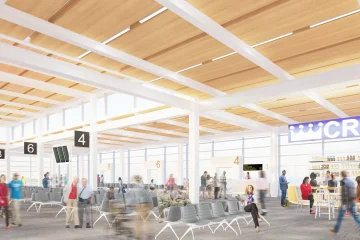Retaining walls serve as vital structures in landscaping, providing both functional support and aesthetic appeal to outdoor spaces. Among the various materials used for constructing retaining walls, sandstone blocks stand out for their durability and timeless beauty.
When properly designed and installed, sandstone block retaining walls can withstand the test of time while enhancing the visual appeal of any landscape.
In this guide, we delve into the key considerations and techniques for constructing durable sandstone block retaining walls that exude both strength and style.
Understanding Sandstone
Sandstone is a sedimentary rock composed of sand-sized mineral particles and rock fragments, primarily quartz and feldspar, cemented together by silica, calcium carbonate, or iron oxide.
Its unique texture and color variations make it a popular choice for architectural and landscaping purposes. Sandstone’s inherent durability and resistance to weathering make it particularly suitable for outdoor applications like retaining walls.
Planning and Design
Site Assessment
Before embarking on any construction project, a thorough site assessment is crucial. Evaluate the terrain, soil conditions, drainage patterns, and the intended purpose of the retaining wall.
Identify potential challenges such as sloping ground, water runoff, or underground utilities that may affect the wall’s stability and design accordingly.
Design Considerations
When designing a sandstone block retaining wall, several factors must be taken into account:
Height and Load Bearing Capacity: Determine the height of the wall and calculate the anticipated loads it will bear, including soil pressure, hydrostatic pressure, and any additional surcharge loads from structures or landscaping features.
Drainage: Proper drainage is essential to prevent water buildup behind the wall, which can exert excessive pressure and compromise its stability. Incorporate drainage systems such as weep holes, perforated pipes, or gravel backfill behind the wall to facilitate water drainage.
Backfill Material: Choose suitable backfill material that provides adequate support and drainage while minimizing soil erosion. Well-compacted granular fill, such as crushed stone or gravel, is commonly used to ensure proper drainage and stability.
Base Preparation: A stable and level base is crucial for the longevity of the retaining wall. Excavate and compact the base material to provide a solid foundation that evenly distributes the weight of the wall.
Construction Techniques
Installation Process
Follow these steps for the construction of a sandstone block retaining wall:
Excavation: Utilize the specialized services of MRN Excavations to commence the excavation process for the construction of the retaining wall. Dig a trench for the wall’s foundation, ensuring sufficient width to house the base material and depth for optimal support.
Base Preparation: Compact the excavated area and add a layer of granular fill to create a stable base for the retaining wall. Use a plate compactor to achieve proper compaction and ensure uniform support.
Placement of First Course: Lay the first course of sandstone blocks along the trench, ensuring they are level and aligned. Use a spirit level and string line to maintain accuracy.
Construction of Subsequent Courses: Continue stacking additional courses of sandstone blocks, interlocking them to provide stability and strength. Backfill the space behind the wall with granular fill and compact it periodically to prevent settling.
Compaction and Drainage: Compact the backfill material behind the wall to eliminate voids and improve stability. Install drainage features such as weep holes or perforated pipes to facilitate water drainage and relieve hydrostatic pressure.
Capping and Finishing: Complete the retaining wall by installing capstones or coping units on the top course to provide a finished appearance and protect the wall from weathering. Ensure the capstones are securely bonded and level to create a seamless finish.
Mortar vs. Dry Stack
Sandstone block retaining walls can be constructed using either mortar or dry stack techniques:
Mortar: Mortared retaining walls involve the use of a cementitious mortar to bond the sandstone blocks together. While mortar provides additional strength and stability, it requires skilled craftsmanship and proper curing to achieve optimal results.
Dry Stack: Dry stack retaining walls rely on the interlocking design of the sandstone blocks to create a stable structure without the need for mortar. Dry stack walls offer flexibility in design and are relatively easier to construct, making them a popular choice for DIY enthusiasts.
Maintenance and Care
To ensure the longevity and durability of a sandstone block retaining wall, regular maintenance and care are essential:
Inspect for Damage: Periodically inspect the retaining wall for any signs of damage, such as cracks, displacement, or erosion. Address any issues promptly to prevent further deterioration.
Clean Regularly: Remove debris, dirt, and vegetation that may accumulate on the surface of the retaining wall. Use a soft-bristled brush or a pressure washer on a low setting to clean the sandstone blocks without causing damage.
Sealant Application: Consider applying a breathable sealant to the surface of the sandstone blocks to enhance their natural color and protect them from moisture absorption, staining, and efflorescence.
Vegetation Management: Monitor and control vegetation growth near the retaining wall to prevent roots from compromising its stability. Trim overhanging branches and avoid planting large trees or shrubs in close proximity to the wall.
Conclusion
Sandstone block retaining walls offer a harmonious blend of strength and style, making them a popular choice for landscaping projects of all scales.
By following proper planning, design, and construction techniques, coupled with regular maintenance and care, these durable structures can enhance the functionality and beauty of outdoor spaces for years to come.
Whether used to terrace sloping terrain, create garden beds, or define outdoor living areas, sandstone block retaining walls are a timeless addition to any landscape.




